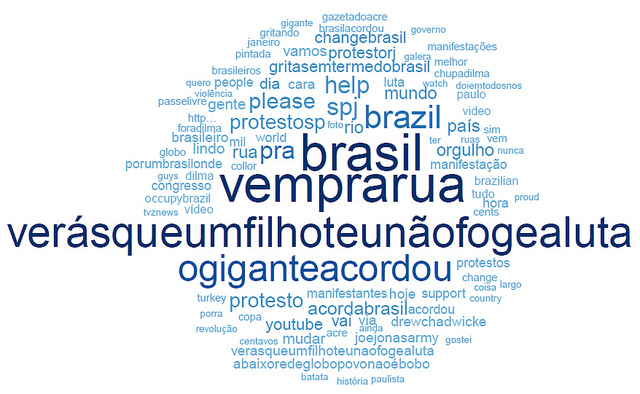
Twitter has become a global protest staple. Along with the spread of Guy Fawkes masks, the service has become an all too common feature in the many world-wide protests of this decade. The recent protests in Brazil are proving to be no different, and researchers are documenting the use of the service in the Brazil protests which have swelled in numbers since their beginning.
Microsoft Research Fuse Labs researchers Andrés Monroy-Hernández and Emma Spiro recently published an excellent write-up focusing on the protests and the user of social media by protestors. The researchers’ work has found three key points about the Brazil protests and Twitter, documenting the peak of protest related tweets, the international nature of the protests, and cyclical behavior of the active users.
First, the protestor’s tweeting seemed to peak on June 17 when protestors, “swarmed the Brazilian Congress.” To measure tweet activity in Brazil that correlated with the protests, the researchers looked for specific hashtags that related to the protests after gathering all of the 1.5 million tweets made from June 1 through 22.
Searching through popular hashtags is reminiscent of the search method used previously to document tweets in Mexico about the drug war. This might not find every tweet related to the incident (as not all tags become popular), but the method does find the bulk of them.
The drop in activity after June 17 is interesting. It seems that protestors tweet more and more as they make gains (be they symbolic or physical) in their activities. Nothing as significant as the protestors taking the Brazilian Congress has occurred since the 17, so naturally the tweets declined. Had more significant advances been made by the Brazilian protestors, it’s possible that tweets would’ve peaked after the 17.
Regarding the “international nature” of the events, an interesting trend occurred during the Brazil protests. Half of the tweets from June 15 to 22 did not come from Brazil. The top time zones that tweeted about Brazil out side of the “Brasilia” timezone came from the Santiago, Greenland, Mid-Atlantic, Hawaii, Quito, Atlantic (Canada), Eastern (U.S. & Canada), London, Pacific (U.S. & Canada), Buenos Aires, and Istanbul.
However, it is interesting that Istanbul comes up as one of these timezones. Turkey is in the midst of it’s own protest movement over the reconstruction of an Ottoman era barracks in Gezi Park. While Turkey does not cover all of the Istanbul time zone (Ukraine, Ethiopia, and Finland are also in it), it’s interesting to note. The researchers write that the actual amount of tweets from Istanbul was “very small,” but “conversation rates follow a pattern of delay compared to the bulk of the tweets,” which suggests that the tweets coming from Istanbul with the Brazil hashtags followed the tweets from Brazil. Istanbul tweets peaked on June 18, a day after the Brazilian tweets peaked on the 17, suggesting that protestors across the world are showing solidarity across the internet through tweets.
There is obviously an interest in protesting countries about other protests.
Lastly, the researchers have documented that the interactions of the network tend to return to their beginnings. The structure of the interaction network of the most active users, which they define by users who post at least 20 tweets in total, exhibits cyclical behavior over the week. Over the course of the eight days, June 15 to 22, activity peaks on Monday, June 17, and descends in volume. Activity returns to relatively normal levels after Saturday, June 22, with Twitter reverting to a “structural configuration similar to the way it began” on the 15.
Obviously, there is still plenty to study with how Twitter is used in protests. It has become the protestor’s organization and communication tool, allowing protestors across large areas of land and across continents to communicate in conditions where traditional methods of communication might be difficult, or impossible. It allows for a concise overview and idea of what is going on across the nation.
With the protests continuing in Egypt, and the seeming frequency of protests, we can be sure that there will be more opportunity to study and learn about how people use Twitter in these situations. That said, the ability for protestors on the ground to disseminate information and images of what is going on with immediacy, it’s no surprise that governments are fond of trying to shut down Twitter when people rise up.
To read the study in its entirety click here.

